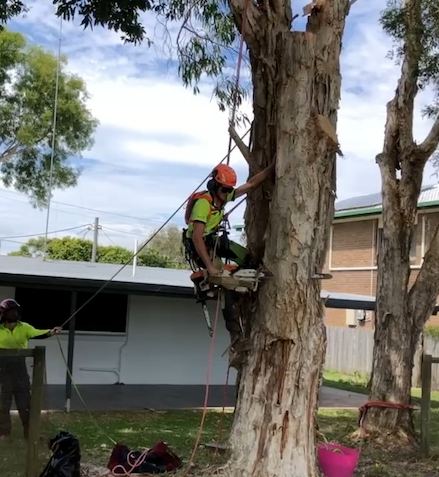Removing an Overhanging Tree Branch
Case Study: Tree Lopping in Doonan – Protecting a Home’s Alfresco Area
Introduction
In the leafy suburb of Doonan on Queensland’s Sunshine Coast, homeowners often enjoy spacious gardens filled with established trees and native plants. While these trees provide shade, beauty, and wildlife habitat, their growth sometimes brings them into conflict with nearby structures. Superior Tree Service was recently engaged to assist a long-term client in Doonan whose well-maintained garden included a large tree that had developed an overhanging branch above their alfresco area. Concerned about the potential risk of storm damage, the homeowner sought a professional solution that would safeguard their property while preserving the health and beauty of the tree.
Background
The client had invested years of care into their property, cultivating a thriving outdoor space filled with healthy plants, trees, and landscaped garden features. The centrepiece of the home’s backyard was a modern alfresco entertaining area, a space where the family regularly gathered and entertained guests.
One tree in particular, while healthy, had grown considerably over time. A large branch extended directly above the alfresco roof. During Queensland’s storm season, such branches can pose serious hazards, including roof damage, broken structures, or falling debris that could cause injury. While the tree itself was sound, the client recognised that preventative action was needed before a major weather event turned the overhanging branch into a dangerous liability.
They contacted Superior Tree Service, knowing that the company’s reputation for precision, safety, and tree health management would ensure the branch could be removed with minimal disruption to the property.
Site Assessment and Planning
On inspection, Superior Tree Service identified the main concerns:
- A heavy branch extended across the alfresco roof, creating a direct risk to the home if it failed during a storm.
- The position of the branch meant that cutting and lowering it required great care to avoid damaging the roof or surrounding garden beds.
- The tree was otherwise healthy and did not require removal, only targeted lopping to eliminate the immediate hazard.
The team explained the process to the client and developed a plan that included:
- Safe access to the branch using climbing gear and rigging systems.
- Controlled lowering of each section of the branch to prevent any falling debris onto the roof.
- Preservation of the tree’s structure, ensuring the cut was made at the correct point to allow for natural healing.
- Site protection for the alfresco area, gardens, and outdoor furniture during the work.
With the client reassured by this approach, the lopping was scheduled for a calm day to minimise risk.
The Tree Lopping Process
- Preparation
The Superior Tree Service team arrived on-site with climbing and rigging equipment, chainsaws, and protective gear. Drop zones were cleared, and protective coverings were placed around the alfresco area. The homeowner was updated on the plan before the work began. - Climbing and Rigging
An experienced arborist climbed the tree and secured themselves with a harness and rope system. A rigging pulley was set up to allow sections of the branch to be safely lowered to the ground without freefall. - Controlled Sectioning
Because the branch extended directly above the alfresco roof, it was not possible to remove it in one cut. Instead, the arborist cut the branch into smaller sections. Each piece was carefully tied, cut, and lowered by rope, ensuring complete control. This process prevented any damage to the roof or garden below. - Final Cut and Shaping
Once the main overhanging branch was removed, the arborist made a final pruning cut at the correct point on the tree to encourage proper healing. The cut was made just outside the branch collar, which reduces the risk of decay and allows the tree to recover naturally. Minor balancing cuts were also carried out to maintain the tree’s natural appearance. - Clean-Up and Mulching
After the branch was removed, all debris was processed on-site. Smaller sections were mulched and left for the homeowner to use in garden beds, while larger timber was cut to size for potential use as firewood. The work area, including the alfresco and surrounding garden, was cleaned thoroughly.
Results
The project was completed efficiently and without any disruption to the client’s home or garden. The overhanging branch was safely removed, eliminating the risk of storm-related damage to the alfresco roof. The tree itself remained healthy and well-shaped, continuing to enhance the landscape while no longer posing a threat to the property.
The client was extremely satisfied with the outcome, noting that the work was carried out with precision, care, and respect for the surrounding environment. They were particularly impressed with how seamlessly the large branch was lowered and removed without causing a single mark to their alfresco structure.
Conclusion
This Doonan case study highlights how Superior Tree Service delivers practical, safe, and professional solutions for homeowners facing tree-related risks. By focusing on targeted lopping rather than removal, the team preserved the tree’s health and beauty while protecting the homeowner’s investment in their alfresco living space.
The project reflects Superior Tree Service’s commitment to:
- Safety first – ensuring people and property are protected.
- Professional arboriculture practices – using correct pruning methods that support long-term tree health.
- Respect for property and gardens – working carefully in sensitive areas without damage.
For homeowners across the Sunshine Coast, this case demonstrates that with the right expertise, large trees can continue to thrive while coexisting safely with homes and outdoor living spaces.
Superior Tree Services — Safe. Reliable. Professional.
Call us today or visit our website to schedule your free consultation.
Tel:0492 911 058
Project Details
- Client – Residential
- Suburb – Doonan, QLD
- Task – Remove an overhanging tree branch

